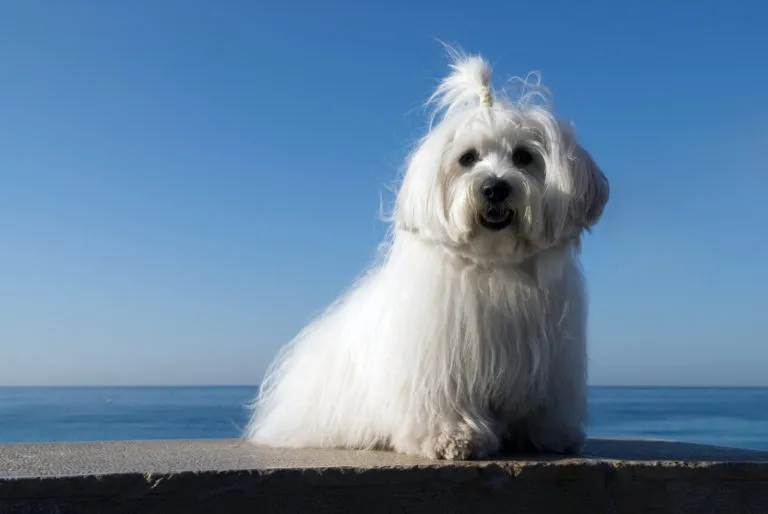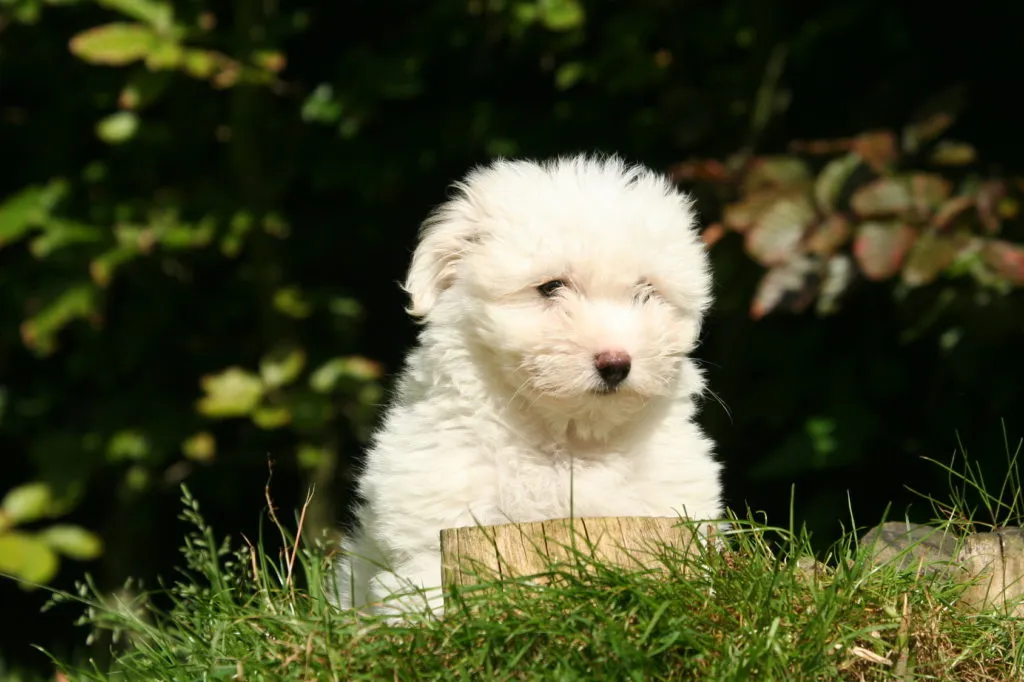Medium Size Poodle
In French colonial times, the Coton de Tuléar was a favourite among the French upper class in Madagascar. Today, this charming dog delights many more pet lovers with its enchanting personality and appealing appearance. However, enthusiasts might have to travel far, depending on the region, to call one of these companion dogs their own: the Coton de Tuléar is still quite rare.

© geronimo / stock.adobe.com
The Coton de Tuléar’s character is as soft and charming as its appearance.
This little charmer wins the hearts of many dog lovers at first sight, looking irresistibly cuddly. No surprise, since the first part of its name hints at a prominent feature: “Coton” is French for “cotton” and relates to this fluffy dog’s appearance. Weighing around 6kg, its soft fur is always white, though small lemon-yellow or grey spots are acceptable, particularly near the drooping ears.
The coat, as per the standard, shouldn’t feel harsh or coarse; it’s lush and can fall in light waves. The nose is typically black, though brown is acceptable, and the wide-set eyes are either black or brown. The shoulder height is approx. 28 to 30cm, with the dog being longer than tall according to the standard.
The second part of the name refers to its origin: “de Tuléar” from Tuléar, a province and city in southwest Madagascar, now commonly called “Toliara”. Legend has it that a ship once sank off the coast of Madagascar, and the Bichon dogs on board were saved, becoming ancestors of today’s Coton de Tuléar. It’s more likely the fluffy ancestors arrived with French administrators during the French colonial rule (1895 – 1960).
Facts indicate the Coton’s relation to breeds like Bichon Frisé, Bolognese, Havanese, Maltese and Löwchen. In Madagascar, the Coton de Tuléar was a companion and prestige object for the wealthy French upper class. Post-colonial times saw French dog lovers continuing exclusive breeding while the breed faded into obscurity in Madagascar, leaving wild descendants.
In France, the “Cotton Dog” increasingly gained popularity and now has many followers worldwide. In 1970, the FCI recognised the Coton de Tuléar as an official breed. Though its origin is Madagascar, France oversees the breed standard. Some breeders still look to Africa, using wild captures to refresh the bloodline and diversify the gene pool.
 © Dogs / stock.adobe.com
© Dogs / stock.adobe.com
The breed standard explicitly highlights how important a friendly temperament is: the Coton de Tuléar’s character is as soft and charming as its appearance. Known for being gentle and affectionate, it adapts well and enjoys being around children and other pets, especially fellow dogs.
However, caution is advised with small animals. It’s more curious than distrustful towards strangers, often announcing their arrival loudly. While the breed can be quite vocal, proper training prevents excessive barking. A balanced Coton de Tuléar is always up for adventures and brings joy with its cheerful nature. Unlike some dogs, it’s rarely anxious or restless when properly engaged. Training this dog, with the necessary consistency, is manageable even for enthusiastic beginners. A dog school can provide valuable support in this process.
Though all Bichons don’t require extensive exercise through long walks, the Coton de Tuléar loves to play and romp outdoors. Naturally, an adult “Cotton Dog” will join you for hikes, but due to its size, it isn’t suitable for accompanying you on bike rides or intense jogging sessions. Be cautious in the forest – some Cotons are avid hunters when they spot a mouse. Train recall with puppies to start good habits early. Activities like dog dancing or agility for small dogs are well-suited for this breed. Your Coton will also love learning tricks – consider trying clicker training.
Like many small breeds, the Coton de Tuléar is prone to patellar luxation. Choose a breeder who prioritises health and uses only healthy parent dogs. Investing in a reputable breeder is crucial for your dog’s long-term health. Generally, the Coton de Tuléar is a robust little dog. In summer, ensure it stays cool under its fluffy fur and provide access to a cool spot.
Daily health contributions include proper mental and physical engagement and a good diet. The “Cotton Dog” needs meat-rich food. Avoid varieties with grain and ensure that meat is the primary ingredient in wet and dry food. If you plan to change your dog’s diet, do so gradually to avoid sensitivity reactions. Feed puppy food in up to four daily portions, and two meals for adults. Given the fluffy appearance can obscure its waistline, regularly weigh your Coton to track any weight changes. Ensure fresh drinking water is always available.
While the Coton de Tuléar is generally easy-going, its coat care requires more dedication. Daily brushing is necessary to prevent tangles.
Tip: Moisten the coat with a grooming spray before brushing to avoid breaking the fine hair.
This fluffy white dog also needs regular baths: start this grooming ritual early with puppies. Use mild dog shampoo and conditioner for easier future maintenance. A baby bathtub can be a suitable size for washing, and remember to brush your dog beforehand to prevent tangles. Despite the fur’s volume, there’s no undercoat, resulting in minimal shedding and less vacuuming. Check its claws every two weeks to see if they need trimming. Light dogs like the Coton often don’t wear their claws down quickly, so regular trimming prevents injuries.
The “Cotton Dog” suits many pet lovers: families, singles, and especially seniors will find a delightful companion in this breed. It’s crucial that this affectionate dog isn’t left alone for long, as it thrives on companionship. For working individuals, it’s suitable only if the dog can join them in the office.
Owners also need to enjoy grooming, seeing it not as a chore but a part of daily bonding. Even beginners can get along well with these friendly dogs. Interestingly, non-shedding fur makes it potentially suitable for some allergy sufferers, but they should consult a doctor and spend time with the breed first to be sure.
 © Mikkel Bigandt / stock.adobe.com
© Mikkel Bigandt / stock.adobe.com
Found your dream dog and ready to welcome a Coton de Tuléar? Congratulations! Use the waiting period to prepare. Look for a dog school, read up on training or refresh your knowledge on puppies, and get a basic kit to ensure your dog feels at home from day one: beds, bowls, carriers, lead with harness or collar, and toys. Also, stock up on grooming accessories like combs, brushes, flea combs, tick removers, dog shampoo, and conditioner.
We wish you much delight with your cheerful Coton de Tuléar!
Love the Coton de Tuléar? You might also like:
Fans of the Bearded Collie agree that those who aren't familiar with this dog breed simply have to get acquainted with it. And those who have experienced how a Bearded Collie bolts across meadows with its flowing fur, how it rolls around full of energy and joy and how it attentively and observantly takes into account its owners wishes become simply addicted to this original dog breed and its unique charm.
The Goldendoodle isn't a breed, but a pairing between Golden Retrievers and Medium or Standard Poodles. Marketed as a low-maintenance dog for allergy sufferers, this hybrid is enjoying increasing popularity amongst dog lovers, similar to the Labradoodle.